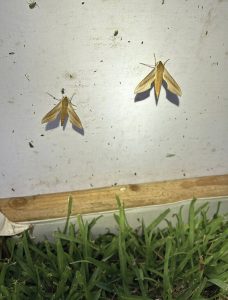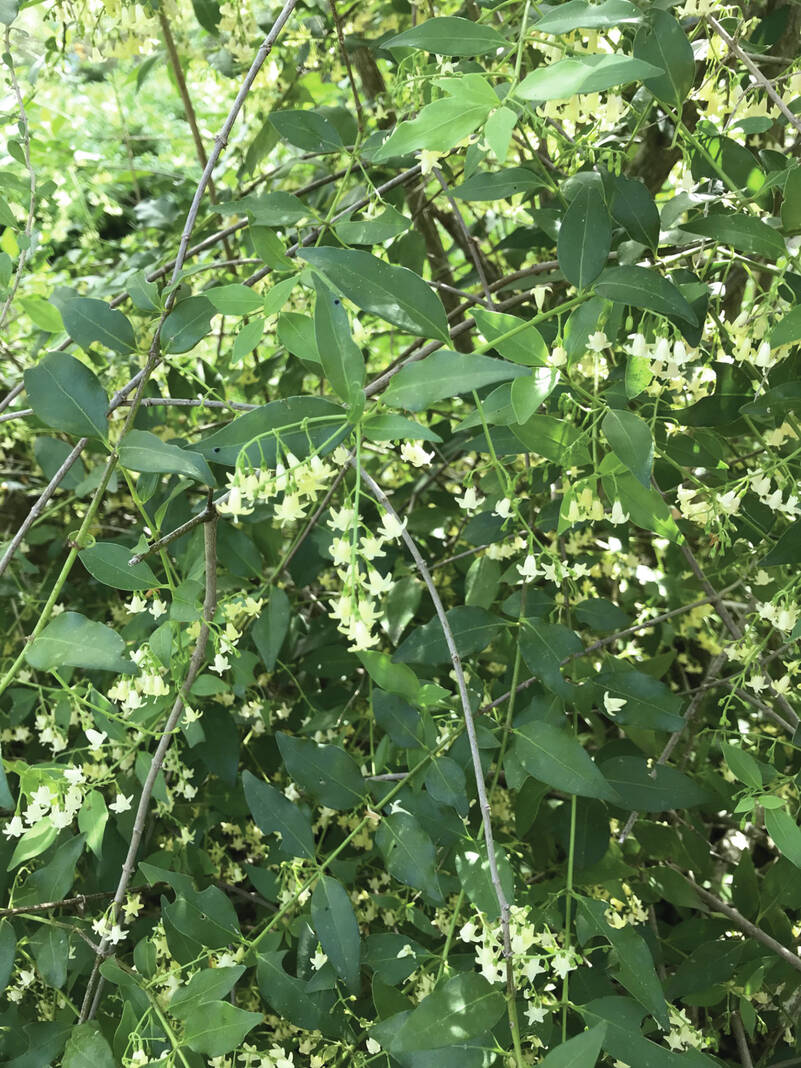 Attracted to a moth sheet, the larger Tersa sphinx moth is the female. (Anita Westervelt | Courtesy photo)
Attracted to a moth sheet, the larger Tersa sphinx moth is the female. (Anita Westervelt | Courtesy photo)Sometimes garden finds defy your notion of what to expect from nature.
The caterpillar of a Pluto sphinx moth is a fascinating example of finding something weird in the bushes. In its last development stage, the Pluto sphinx moth caterpillar has conspicuous false eye markings, an adaptation meant to warn a predator that is about to attack that it is messing with a much larger and potentially more dangerous prey than what it really is. The eye spots are a vulnerable caterpillar’s equivalent to saying, “Back off.”
South Texas and southern Florida are the northernmost ranges of the Pluto sphinx moth, Xylophanes pluto; its range extends south to Brazil. The moths can be somewhat rare at the range fringes.
For all a caterpillar’s harmless existence, they have enemies. Birds, spiders, wasps and a group of insects called true bugs are a danger to both moth and butterfly caterpillars. Along with the eye spots, the strikingly marked Pluto sphinx caterpillars have a couple more survival tactics. They begin feeding at dusk and feed throughout the night; during the day, they hide at the base of their host plant or in nearby vegetation. When eating, they are likely to munch from the underside of a leaf rather than visibly on the leaf top.
Pluto sphinx caterpillars can be green, brown or brown-purple. As they near pupation, their bodies are plump, bulbous at the thoracic eyespots and then tapered, ending with a curved horn that hooks down. The caterpillars can grow to more than two inches in length.
The Pluto sphinx moth uses various species as larval host plants that vary throughout its range, including plants in the coffee family. In Texas, the moths lay their eggs on plants that are not necessarily native to the Rio Grande Valley.
Interestingly, the crawly critters blend well with one local larval host plant that displays the same coloration as the growing caterpillars: a shrub with red stems and red-veined greenish-orange and red colored leaves. Locally called firecracker shrub, Texas firebush and hummingbird bush, its scientific name is Hamelia patens. It is native to Mexico and Central and South America.
Although not native, firecracker shrub is a popular perennial for the southern half of Texas. A prolific bloomer, hummingbirds are attracted to its red tubular shaped flowers. The plant is drought tolerant, grows in full to partial sun in well-drained soil. Occasional shearing helps keep it blooming during most of the year.
Another host plant is pentas, also not native, it is a Texas Superstar plant — “plants specially recognized for superior performance in tough Texas growing conditions.” https://texassuperstar.com/ and https://texassuperstar.com/pentas-2/.
 David’s Milkberry shrub. (Anita Westervelt | Courtesy photo)
David’s Milkberry shrub. (Anita Westervelt | Courtesy photo)A host plant in the coffee family is David’s milkberry, Chiococca alba, a rare plant native to the extreme southern tip of Texas. Both firecracker shrubs and pentas also are host to the Pluto sphinx’s cousin, the tersa sphinx, Xylophanes tersa.
The adult Pluto sphinx moth is as beautiful as the caterpillar is peculiar looking. The forewings are two-toned velvety shades of olive-drab and celery-green colors. The olive-green thorax and abdomen have gold metallic looking dots at the base of each abdomen segment. The moth has a two and one-half-inch wingspan. Adults draw nectar from and help pollinate flowers such as verbena.
I was not lucky enough to see the Pluto sphinx transformation from caterpillar to moth, however, there are quite a few recorded observations of the moth in the iNaturalist.org database from Hidalgo and Cameron counties, most recently around McAllen during April and May. The observations are highlighted in the map section at this link: https://www.inaturalist.org/taxa/143839-Xylophanes-pluto
Moths like the Pluto sphinx deserve credit for being important pollinators for many wild and cultivated plants. Moths and other interesting night flying insects are attracted to lights at night and to black light and moth sheet set ups.
National moth week is coming up. It is an annual, worldwide opportunity to educate and celebrate the beauty, life cycles and habitats of moths around the world. Closer to home, nearby city, county and state parks may have special mothing events. Contact parks and ask about moth week activities.
Although host plants are not necessary to attract moths, many park giftshops carry Weber, Jim and Weber, Lynne’s book, “Native Host Plants for Texas Moths: A Field Guide.” It also is available at Texas A&M University Press: https://www.tamupress.com/search-results/? category=TAMUGG
For details for setting up your own yard to attract moths, how to participate as a citizen scientist and for more information about mothing and national moth week, check out this link: https://nationalmothweek.org/
These sources were helpful in writing this article: bugGuide.net, aggie-hort.tamu.edu, wildflower.org, sphingidae.us/
Anita Westervelt is a Texas Master Naturalist.
The post Moths contribute to the amazing ‘wow factor’ of nature appeared first on MyRGV.com.
 (2).png)
 2 months ago
72
2 months ago
72








 English (US)
English (US)